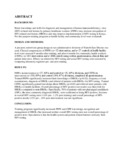| dc.description.abstract | BACKGROUND:
Better knowledge and skills for diagnosis and management of human immunodeficiency virus (HIV) related oral lesions by primary healthcare workers (PHWs) may increase recognition of HIV-related oral lesions (HROLs) and may improve implementation of HIV testing in Kenya. For this purpose training programs at health facility and community level were evaluated.
DESIGN AND METHODS:
A pre-post control-test group design in two administrative divisions of Nairobi East District was used. Clinical competencies of PHWs (n = 32 intervention, and n = 27 control) at health facility level were assessed 9 months after training, and after 6 months for community health workers, (CHWs) (n = 411 intervention and n = 404 control) using written questionnaires, clinical data and patient interviews. Effects on referral for HIV testing and actual HIV testing were assessed by comparing laboratory registries pre- and post training.
RESULTS:
PHWs in intervention (n = 27; 84%) and control (n = 15; 60%) divisions, and CHWs in intervention (n = 330; 80%) and control (189; 47%) divisions, completed all questionnaires. Trained PHWs significantly increased their knowledge of HROLs (p<0.02), frequency of oral examinations, diagnosis of HROLs and referral of patients with HROLs for HIV testing. Trained CHWs significantly gained knowledge about HROLs (p<0.02) and referred more patients with HROLs to health facilities. Overall percentage of HIV-positive test results was three-fold for HROLs compared to non-HROLs. Specifically, 70% of patients with oro pharyngeal candidiasis (OPC), the most commonly diagnosed HROL, were confirmed as being HIV-positive. Increase in overall HIV testing rates (1.6% pre-, 1.2% post training) and overall percentage of HIV-positive results (13% pre-, 16% post-intervention) was not significant.
CONCLUSION:
Training programs significantly increased PHW and CHW knowledge, recognition and management of HROLs but increased neither overall HIV testing rates nor overall percentage of positive tests. Speculation is that the health system and patient-related barriers seriously limit HIV testing. | en_US |


